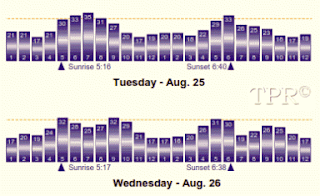 |
| Two circular diagrams showing the division of the day and of the week, from a Carolingian manuscript (Clm 14456 fol. 71r) of St. Emmeram Abbey. The day is divided into 24 hours, and each hour into 4 puncta, 10 minuta and 40 momenta. Similarly, the week is divided into seven days, and each day into 96 puncta, 240 minuta and 960 momenta. |
The earliest
reference we have to the moment is from the 8th century writings of the
Venerable Bede. Bede describes the system as 1 hour = 4 points = 10 minutes =
15 parts = 40 moments. Bede was referenced four centuries later by Bartholomeus Anglicus in his early encyclopedia De
Proprietatibus Rerum (On the Properties of Things). Centuries after Bede's
description, the moment was further divided into 60 ostents, although no such
divisions could ever have been used in observation with equipment in use at the
time. Source: Wikipedia
















